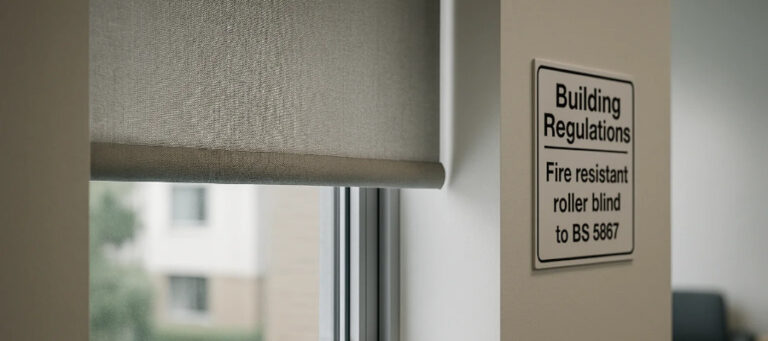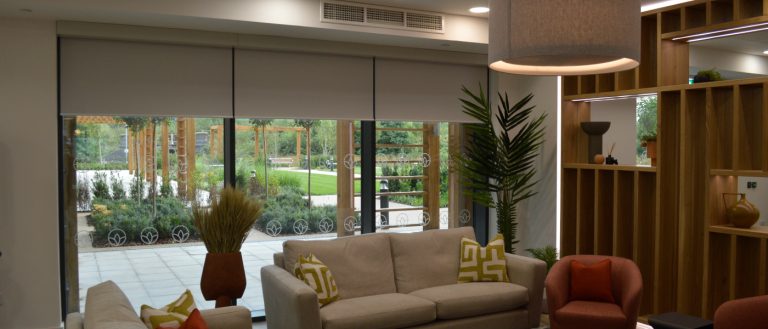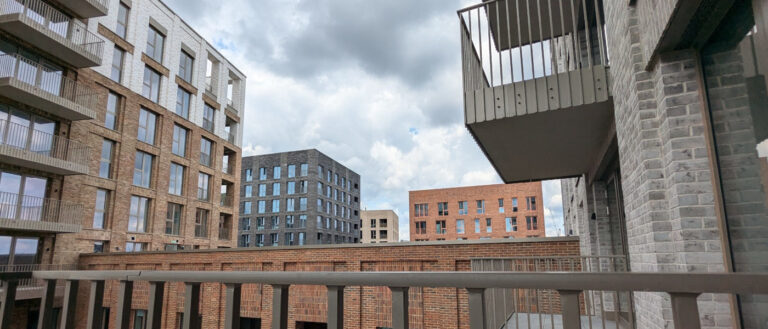Choosing Window Treatments for Hospitals & Healthcare Facilities
The healing atmosphere of a hospital or healthcare facility goes beyond just medicine and treatment.
The ambience and environment also play a pivotal role in a patient’s recovery and comfort. This is where something as simple as the right window treatment can make all the difference.
You may not immediately associate blinds and shades with patient care, but they significantly impact various factors that contribute to healing and well-being.
From upholding hygiene standards and reducing noise to ensuring privacy, the appropriate window solutions check many requisites in a healthcare setting.
So when you’re looking at the windows in a hospital room or ward, think beyond just décor.
The style, fabric, operation and other aspects directly tie into patient care in their own ways.
Blinds in Healthcare: More Than Just Decor
In hospitals, window treatments do much more than just look nice, they take on a profoundly significant role.
They contribute to comfort, privacy and the overall healing environment.

Blinds and Their Role in Patient Care
In healthcare, every element must work together to support patient recovery:
- Hospital Blinds: Not just window dressings, but key features that add both functionality and comfort.
- Healthcare Blinds: Designed to meet the demands of healthcare environments, offering durability and practical use.
Prioritising Patient Privacy
Blinds act as silent protectors, helping patients maintain their dignity:
- Shielding from Outside View: Ensuring privacy during vulnerable moments.
- Natural Light with Privacy: Allowing light in while still protecting patient privacy.
Upholding Hygiene with Antimicrobial Fabric
Choosing the right materials is critical for infection control:
- Antimicrobial fabric – Actively impedes microbial growth, essential in blinds for patient areas.
- Easy to clean surfaces – Promotes a sterile environment, crucial for recovery rooms and wards.
Noise Reduction: The Role of Blinds in Ensuring a Tranquil Environment
Blinds can also help reduce noise:
- Sound Absorption: Softens echoes and muffles noise from corridors.
- Creating Calm: Promotes rest and relaxation, essential for healing.
Blinds in healthcare are more than just decor—they provide privacy, cleanliness, and calm. Thoughtful selection makes them integral to patient care.
Types of Hospital Blinds and Their Features
At Enviroscreen Systems, we know that terms like ‘healthcare blinds’, ‘medical blinds’, and ‘hospital-grade blinds’ all mean meeting the high standards of healthcare.
Our blinds meet these critical needs and integrate essential features seamlessly.
Hospital window blinds do much more than look good. They play a big part in the atmosphere and function of a space.
Durability
In a hospital setting, blinds are subjected to frequent use and rigorous cleaning protocols.
Our blinds are built to withstand this demanding environment, ensuring longevity and maintaining appearance and functionality over time.
Light Control
The ability to control natural light is crucial in healthcare settings. Proper light management can aid in patient recovery, regulate sleep cycles and provide necessary privacy.
Our blinds are designed to offer precise control over light, allowing healthcare staff to create the optimal environment for patient care and comfort.
Privacy and Comfort
Patient privacy is paramount in healthcare settings. Our blinds provide the necessary seclusion for patients during their recovery, allowing them to rest and heal in a private and secure environment.
The comfort aspect is also a key consideration; our blinds help create a tranquil and soothing space, which is essential for patient well-being.
This alignment of practicality with patient care is what sets our blinds apart and makes them a preferred choice in the healthcare industry.
Hospital Window Blinds: The Unique Features
Each type of blind carries its unique set of features, suited to different needs and areas within a healthcare facility.
From ensuring patient privacy to enhancing comfort, the right blinds can transform a space into a sanctuary of healing.
Let’s explore the various options and their specific roles.
Blackout Blinds: Their Significant Role in Healthcare
Blackout blinds play a pivotal role in healthcare settings. They ensure total darkness, crucial for patient recovery and restful sleep.
By offering complete privacy and reducing glare, these window coverings create a comfortable and soothing environment for patients in vulnerable states.
Cassette Blinds: Design Insights
Cassette blinds, known for their sleek and efficient design, are particularly suitable for areas in hospitals that require precise control of light, such as ICUs and consultation rooms.
Their discreet and effective functionality makes them a preferred choice in modern healthcare facilities.
Vertical vs. Roller Blinds: Dissecting the Two Types
Vertical blinds are often chosen for larger windows, providing precise light control, which is ideal for administrative areas.
In contrast, roller blinds, with their simplistic and efficient design, are more common in standard-sized patient rooms.
Custom Blinds: Why Customisation Matters
Customisation is key in healthcare settings, as windows can vary greatly in size and shape.
Custom blinds ensure that every window, irrespective of its dimensions, can be adequately covered, thereby meeting the specific requirements of different areas within a hospital.
Rooflight and Skylight Blinds: The Significance of Overhead Window Blinds
Managing light in areas with atriums and high ceilings is crucial, and this is where rooflight and skylight blinds come into play.
They provide control over direct sunlight, which is particularly important in upper floors of healthcare facilities.

Anti-ligature Blinds: Ensuring Patient Safety
In mental health and high-risk areas, anti-ligature blinds are essential.
They are designed to eliminate ligature points, ensuring the safety of patients in these sensitive environments.
Laser Blinds: Advanced Tech Meets Blinds
In specialised areas like laser treatment rooms, laser blinds offer the cutting-edge technology required to meet specific needs, blending advanced functionality with the essential utility of blinds.
Motorised Blinds: Why Automation is Pivotal in Healthcare
Motorised blinds represent a blend of convenience and functionality.
Their automated nature allows for easy adjustment, which is crucial in healthcare settings, ensuring minimal noise and disturbance, thus contributing to the overall comfort of patients.
In summary, the choice of blinds in a healthcare setting is a critical one, impacting not just the aesthetics but also the functional and psychological aspects of patient care.
Choosing the Right Blinds for Healthcare
Selecting the right blinds for a healthcare setting isn’t just about aesthetics; it’s about finding a solution that aligns with the unique requirements of the environment.
Here’s how to ensure that the blinds you choose are the perfect fit for your healthcare facility.
Types of Hospital Blinds: An Overview of Varieties
Hospital blinds come in various types, each designed to cater to specific needs within a healthcare environment.
Standard Operational Blinds
This category features roller and vertical blinds. Roller blinds, known for their straightforward and effective design, are ideal for standard-sized patient rooms.
Vertical blinds are preferred in larger spaces, like administrative areas, for their ability to precisely control light.
Ambient Light Control Blinds
Blackout blinds are crucial for rooms where total darkness is required, such as sleep study centres.
These blinds help regulate light and support patient rest, making them indispensable in areas where controlling ambient light is key.
Confidentiality Enhancing Blinds
Blinds with opaque fabrics ensure total privacy in patient rooms, while those with adjustable slats allow controlled visibility.
These blinds are vital for maintaining patient dignity while balancing the need for natural light.
Precision Adjustment Blinds
Motorised blinds offer ease and precision in controlling light and privacy. They can be adjusted without disturbing patients, which is particularly beneficial for wards and treatment rooms.
Custom-fit blinds are also essential, as they are tailored to the unique dimensions of hospital windows, ensuring optimal functionality.
Safety and Security Blinds
Anti-ligature blinds are crucial in psychiatric wards and high-risk areas to minimise self-harm risks.
Laser blinds are used in specialised areas like laser treatment rooms, where precise light blocking is necessary for safe procedures.

Each category of blinds plays a pivotal role in enhancing the healthcare environment.
From standard operational blinds that offer simplicity to specialised blinds that ensure safety, the right choice can make a significant impact on both patient care and staff efficiency.
Bespoke Blinds: Ordering to Specifications
Every window has its unique dimensions and requirements, and this is where bespoke blinds come into play.
- Made to Measure: Blinds ordered to size ensure a perfect fit for every window, eliminating gaps that can compromise privacy and light control.
- Expert Tailoring: At Enviroscreen, we specialise in measuring and tailoring window treatments to meet the specific requirements of each healthcare facility, ensuring that every blind is not just a fit but a perfect match.
Installation & Aftercare
Proper installation and aftercare are just as important as the quality of the blinds themselves.
- Professional Installation: Our team at Enviroscreen ensures that every blind is installed with precision, ensuring functionality and longevity.
- Aftercare Service: We address common issues such as fixing broken blinds, and provide guidance on how to replace them. Our aftercare service ensures that your solar shading remains in top condition, maintaining its functionality and appearance.
Choosing the right blinds for a healthcare facility involves considering various factors, from the type and function of the blinds to their installation and aftercare.
At Enviroscreen, we understand these nuances and are committed to providing solutions that meet and exceed the needs of the healthcare sector.
If you’d like to discuss a project, please get in touch by phone or email (info@enviroscreen.org.uk) as we will be able to assist you better.
If however you have a general enquiry about our services, or anything else please feel free to use one of our forms.
Legal & Compliance in Blinds
Navigating the labyrinth of legal requisites and compliance standards for hospital blinds is a critical aspect that cannot be overlooked.
In the healthcare sector, where safety and hygiene are paramount, understanding and adhering to these regulations is not just a matter of legality but of patient welfare.
Essential Legal Requisites
When selecting blinds for a healthcare environment, it’s crucial to be cognizant of the blind’s legal requirements.
These regulations are designed to ensure that the blinds used in hospitals and healthcare facilities meet stringent safety, hygiene and quality standards.
Compliance with these laws is not just a legal obligation but also a moral one, as it directly impacts the well-being of patients and staff.
- Fire Safety: Blinds in healthcare settings must be flame-resistant, adhering to fire safety standards. This is crucial in preventing the spread of fire, thus ensuring the safety of patients and staff.
- Building Regulations: Compliance with building regulations is essential. These regulations often cover aspects such as window size, blind installation and safety features.
Prioritising Infection Control in Blind Selection
In the healthcare sector, infection control is a non-negotiable aspect. The selection of blinds plays a significant role in this regard.
- Antimicrobial Properties: Blinds used in hospitals should have antimicrobial properties. This is vital in preventing the spread of bacteria and viruses, a common concern in healthcare environments.
- Easy to Clean: The materials used for blinds must be easy to clean and maintain. In environments where infection control is critical, the ability to regularly and effectively clean window treatments is paramount.
By prioritising these legal and compliance aspects in the selection of blinds, healthcare facilities can ensure a safer, more hygienic environment for both patients and staff.
Conclusion
As we look towards the future of hospital blinds, it’s evident that innovation and compliance will continue to steer their evolution.
The trends are leaning towards smarter, more adaptable window treatments that not only adhere to stringent health and safety regulations but also enhance the patient experience.
Remember, the choice of blinds in a healthcare facility is a critical decision that impacts the overall healing environment. It’s about creating spaces that are not just functional but also nurturing and safe.
The ongoing advancements in blind technology, materials and design promise even more effective solutions in the years to come.
As a trusted supplier in this field, we remain committed to staying at the forefront of these developments, ensuring that our products continue to meet and exceed the evolving needs of healthcare facilities.
FAQs
Q: Where can I find a blind specialist near me for healthcare facilities?
For professional guidance and a comprehensive range of blinds tailored for healthcare settings, look for specialists with a proven track record in supplying and installing hospital-grade window treatments.
Q: Are blinds supplied and fitted by the same company?
Yes, many blind specialists offer a complete service package, including supply and installation. This ensures a seamless process from selection to fitting, tailored to meet the specific requirements of healthcare facilities.
Q: Are there blinds suitable for high-risk areas in hospitals?
Yes, anti-ligature blinds are specifically designed for high-risk areas, such as psychiatric wards, to ensure patient safety by minimising self-harm risks.
Q: What are the cleaning and maintenance requirements for hospital blinds?
Hospital blinds are designed to be easy to clean and maintain, with materials that can withstand regular cleaning protocols, essential for maintaining hygiene in healthcare environments.
Q: Can hospital blinds be customised for specific healthcare requirements?
Absolutely. Customisation is key in healthcare settings, and blinds can be tailored to meet specific requirements such as size, functionality and safety features, ensuring they perfectly fit and function within the intended space.
Q: What should I consider when selecting blinds for a healthcare setting?
Consider factors such as antimicrobial properties, fire resistance, ease of maintenance, and compliance with safety regulations. Also, assess the specific needs of different areas within the facility, such as patient privacy in wards or light control in treatment rooms.
For enquiries about hospital blinds:
Enviroscreen Systems
Swift House,
13 Ronsons Way,
St Albans,
AL4 9QT
United Kingdom
Telephone: 01727 220 007
E-mail: info@enviroscreen.org.uk







